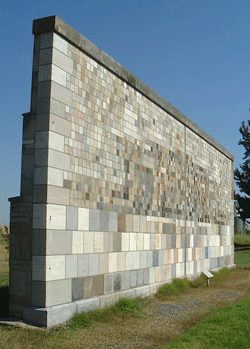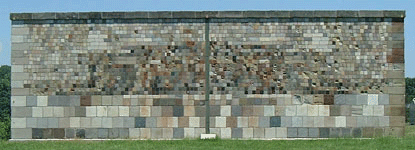Building Stones of America: Over 50 Years of the NIST Stone Test Wall
By Paul E. Stutzman, Jaime Raz
 In 1880, the Census Office and the National Museum in Washington, D.C., conducted a study of building stones of the United States and collected a set of reference specimens from working quarries. The census that year reported descriptions of producing quarries, commercial building stones, and their use in construction across the country. This collection of stones, now augmented with the Centennial Collection of U.S. building stones from the 1876 Centennial Exhibition in Philadelphia, as well as building stones from other countries, has moved around over the years, but still serves its purpose as a stone test wall to study the effects of weathering.
In 1880, the Census Office and the National Museum in Washington, D.C., conducted a study of building stones of the United States and collected a set of reference specimens from working quarries. The census that year reported descriptions of producing quarries, commercial building stones, and their use in construction across the country. This collection of stones, now augmented with the Centennial Collection of U.S. building stones from the 1876 Centennial Exhibition in Philadelphia, as well as building stones from other countries, has moved around over the years, but still serves its purpose as a stone test wall to study the effects of weathering.
Originally on display in the Smithsonian Institution, in 1942 the ASTM Committee
C-18 on Building Stone decided that a study of actual weathering on such a great variety of stone would yield valuable information. The committee developed a plan for using the stones to build a test wall at the National Bureau of Standards (NBS) as a cooperative study with NBS. Subsequently, the test wall was constructed in 1948 at the NBS site in Washington, D.C., then eventually moved intact in 1977 to its present site at NBS, now the National Institute of Standards and Technology (NIST) in Gaithersburg, Md.
Today, the wall provides a rare opportunity to study the effects of weathering on different types of stones, with the climatic conditions being the same for all stones. It offers a comparative study of the durability of many common building stones that have been used in commercial and government buildings, as well as in monuments. Also, the wall has served to preserve a valuable collection of building stone and should be useful as a reference for builders in identifying the kinds of stone that may be locally available.
The wall contains 2,352 individual samples of stone: 2,032 domestic stones from 47 states and 320 stones from 16 foreign countries. It is constructed in a mirror-image pattern, with the stone in the left wall set in lime mortar and the stone in the right wall set in Portland cement mortar. Over 30 distinct types of stones are represented, many of which are common varieties used in building, such as marble, limestone, sandstone and granite.
Stone Studies
In 1998, the Inorganic Building Materials Research Group of the Building and Fire Research Laboratory (BFRL) in NIST started a project to evaluate and document the changes due to 50 years of weathering. The project is sponsored by the National Center for Preservation Technology and Training (NCPPT) of the National Park Service.
This study involves three distinct tasks:
- Development of a methodology to image and describe degradation features of stone and mortar, application of the methodology in creation of a database containing detailed descriptions of the wall and archived stone specimens, and making that database publicly available through digital media and Internet access.
- Detailed petrologic studies of the archival and selected wall micro-core specimens to characterize them with respect to their texture and mineralogy.
- Correlating mineralogical and microstructural features to stone performance, and performance comparisons of similar stones from the same producer that have been used in building construction.
The project consists of creating an archive of images of both the actual stone in the wall and all the archive specimens, which have been stored indoors. The database organizes the images and stone descriptions while providing easy access to the data. This database will be dynamically updated as new data become available (i.e., microscopic investigation of the stone texture and mineralogy, photographs of buildings constructed with these particular stones, and any other research related to the stones).
Approximately two-thirds of the stones in the wall have an archival companion specimen that has been imaged and added to the database. The database allows users to search for the various stones by state or country, by stone type or simply by requesting a specific stone number. It is also easy to browse around the wall just by clicking on the wall's picture. As a result, the user gets a composed display of all the available database information along with two images, one of the indoor, archived specimen and one of the specific stone in the wall. The imaging of the individual stones in the wall was completed in June 2000, and the database is accessible through the Internet at http://stonewall.nist.gov.
Previous studies of the stone collection provide a brief description of rock type and source of the stones used in the wall but do not provide images and descriptions of their mineralogical, textural or surface characteristics. A database containing detailed stone descriptions and images will serve as a baseline from which to evaluate their resistance to weathering in subsequent studies.
Additionally, the database will assist preservation specialists, stone conservators and historic preservation architects with an interest in stone, weathering effects and details not previously possible. In subsequent studies, petrologic analysis will serve to improve our understanding of the influence of the various weathering agents upon a wide variety of stone, improve our understanding of the stone degradation processes, and aid in the selection of appropriate preservation measures.

The Test of Time
As the wall passes half a century in age, interesting degradation features have been observed, including differences in the relative durability of stone and in the way stone (even of the same lithology) perform.
The limestones and marbles generally have faired well, though the surfaces have roughened a bit due to dissolution of the stone. In some cases, this apparently enhanced the stone appearance, as with the Knoxville marbles. In other cases, the surface roughening has increased its susceptibility to trap dirt and stain as overlying stone erode. In some cases, there is a local history for stone application ? the Potomac marble does fine indoors but bleaches out to a gray in the sunlight. In other cases, the relationship between durability and lithology is not so clear. This leads to the third question where some of the durability issues have been studied but others are not so well understood.
As the left side of the wall is set in lime mortar and the right side of the wall in Portland cement, another area of evaluation is available. Observers were concerned that lime mortars could cause discoloration on masonry, so they replaced lime in the Portland cement mortar with ground limestone. Although this will require a more direct comparison, over time the lime mortars have not held up as well as the Portland cement mortars. Discoloration appears to be affected by the coloration and weathering characteristics of the overlying stone.
Conclusion
The bulk of the study is just in the beginning stages for this project. A proposal with the Parks Service regarding evaluation data from an unpublished study containing weathering depth measurements and images will provide an interesting assessment of erosion rates in the future.
About the Authors
Paul E. Stutzman is a member of the Inorganic Building Materials Group at the National Institute of Standards and Technology.
Jaime Raz is a member of the Inorganic Building Materials Group at the National Institute of Standards and Technology.


















